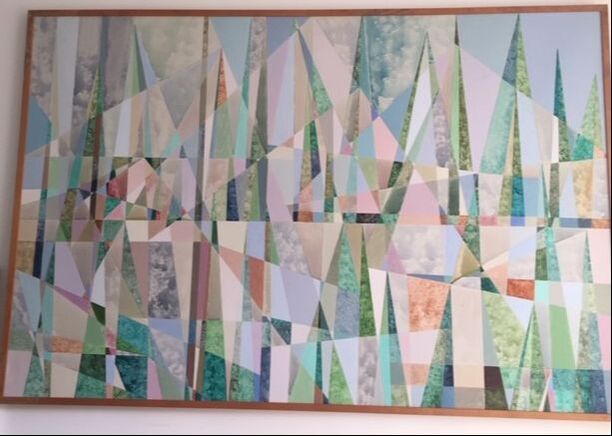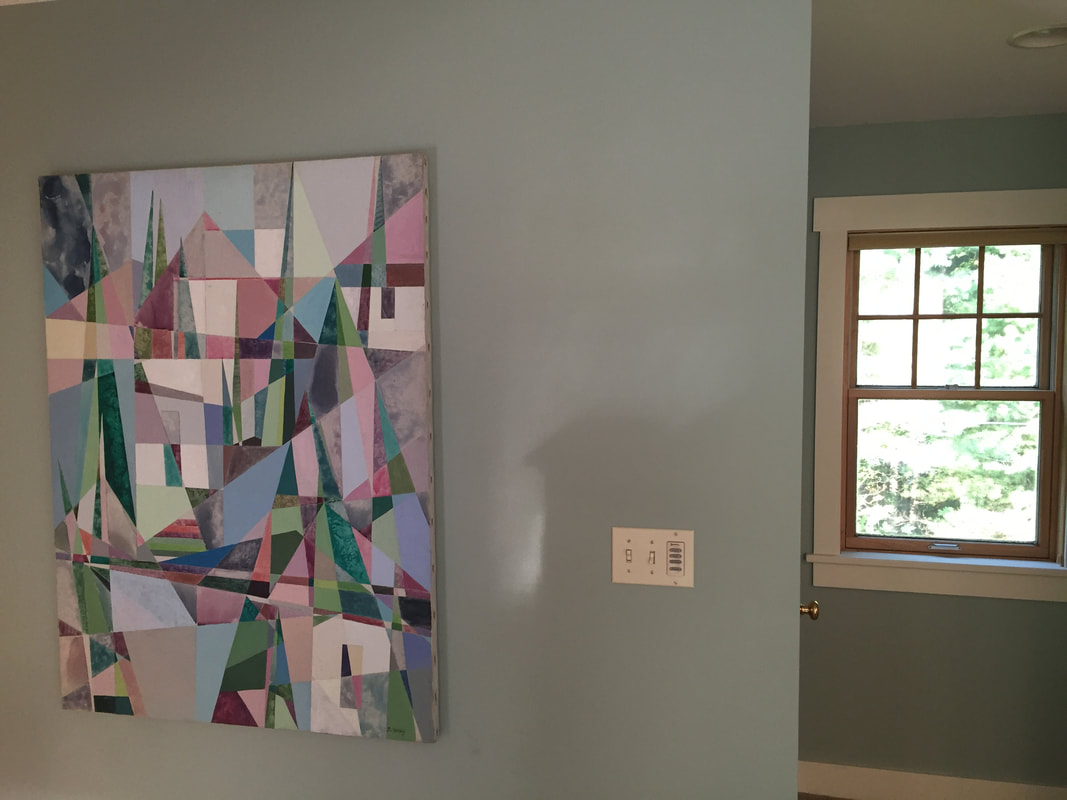|
For many years, Marianne painted in the midnight hours, when the kids were asleep and I was on the road somewhere. After a few hours of sleep, she got up and made school lunches and checked her lesson plans and drove off to teach art.
At some point she produced this large painting, which wound up in a gallery in Manhattan, and then in friends’ apartment on the Upper East Side. But now those friends are downsizing, and no longer have room for the painting, so they graciously offered it back to the artist. In the middle of a pandemic, with no station wagon anymore, we did not see retrieving it and squeezing it into our house, already crammed with books and art and kitchen utensils. Marianne mentioned her dilemma to our West Side friends, who are redecorating their apartment in the 50s. They know her work, and were interested, but the painting had been wrapped, and was sequestered in the basement of the East Side building. So they accepted it, sight unseen. Then came moving day, part of the daily buzz of the city, good times or bad times -- folks clutching modest bags of clothing on the subway, other folks engaging gigantic moving vans that block side streets, out-of-town children of privilege who come clumping down the elevated train stairs with one wheeled suitcase in an “emerging” neighborhood, getting dirty looks from ladies in the local peluqeria whose rents are about to double. (I witnessed that in Bushwick two years ago.) Now our friends were joining the sidewalk shuffle, taking 45 minutes to walk across town, spotting “dog runners and dog strollers in the park, empty buses plying Fifth, a fit couple racing up and down the Met Museum’s steps. The ‘Ancient Playground” at 85th and Fifth still temporarily closed,’” as the lady half of the couple wrote. I had warned that if they tried to carry the painting across town, one of those classic crosswinds that scream out of a side street could pick them up, clutching the painting, and deposit them in Oz, or New Jersey. But it did not come to that, because when the East Side porter delivered the 6-by 4-foot package near the front door, they realized it was so sturdy that blithely carrying it across town – for fun, for exercise – was out of the question. Now began the quest for wheels. They tried shoe-horning it into a city taxi, but it was four inches too long, so they tipped the driver for his effort, and waved farewell. The super helped them carry it to a busy corner and left them to their adventure. They hailed two panel trucks and tried to cajole the drivers into making an excursion, but both apologized for being busy. A plumber parked nearby offered to help but needed an hour to set up his crew. Tired of standing on the corner propping up a large painting, they called a messenger service, New York Minute, which promised to drop it at their building, as they took a taxi back home. An hour later, the painting arrived and they set it on the terrace for a few hours to give germs time to die. They still had not seen the painting that had occupied several weeks of logistics that could have sent a spaceship to a far-off docking station. (Did I mention that Marianne, in her other life as matchmaker, a/k/a the shiksa shadchen, had matched these two friends, not so long ago?) “Unwrapped, it was love at first sight. It’s Marianne’s Geometric Period, mixed media watercolor and oil,” our friend reported. “It miraculously fit on the pre-existing hooks opposite our bed.” They took a photo – the miracle of the smartphone—and beamed it to Marianne, who immediately recognized it from the period, decades ago, when she found a makeshift table that could accommodate larger canvases. She has sold around 250 paintings, some now dispersed around the world. She may not recall the year or the circumstances of each painting, but she recognizes each painting, remembers the creation. She has won awards in juried shows, has placed her work in slide form or real-life form, in Manhattan galleries, has received respectful “keep-painting” receptions from major galleries, some of them part of the art hustle of recent decades, no names mentioned. It all came back to her, including the review in NYT’s Long Island Section, by critic Phyllis Braff: One feels and imagines the aura of the Grand Canyon, Notre Dame, a night sky, a fall landscape or a cemetery in visions that are executed through rather innovative manipulations of small squares made vibrant with mottled, transparent watercolor tones. Color selections that tend to be symbolic, and exacting schemes of dispersing the painted units, are both important in carrying the message. This painting, part of Marianne’s most active period, is now hanging in the bedroom of a fashionable apartment, home to many soirees with art-conscious New Yorkers. But the main reward came when the lady wrote: The painting is now the last the last thing we see at night, and the first thing we see in the morning. Joy. Marianne’s painting has made the daunting crosstown trek from the East Side to the West Side. Its journey has also brought us joy. * * * The review in the NYT by critic Phyllis Braff: https://www.nytimes.com/1983/10/09/nyregion/art-unexpected-messages-in-geomettic-form.html?searchResultPosition=1
Tom Schwarz
6/15/2020 10:13:01 am
It is beautiful!!! Great story
Gene Palumbo
6/15/2020 10:21:53 am
What a great piece.
bruce
6/15/2020 11:10:00 am
george, 6/15/2020 11:33:17 am
Marianne’s painting is a well-blended mix of color and design. It was certainly worthy of a “NYC” style trip to its new home.
Altenir Silva
6/15/2020 12:17:59 pm
Dear George,
George Vecsey
6/15/2020 04:37:54 pm
Dear Tom, Gene, Bruce, Alan, Altenir You have guessed the family dynamics about who the talented one is,
bruce
6/15/2020 05:40:14 pm
george,
Stewart Kampel
6/15/2020 12:22:46 pm
Great story, George and Marianne, and so sorry we haven't seen you in ages. We are in Philadelphia with our daughter and family and don't know when we'll be back in New York. But the painting seems to have weathered extremely well. And I'll take a little credit for hiring Phyllis Braff (and a guy named George). Much love. Susan and Stewart
George Vecsey
6/15/2020 04:42:32 pm
Dear Stewart: I'm glad you have made it as far north as Phila....enjoy the family, and be safe.
Randolph
6/15/2020 06:26:45 pm
Marianne and George,
Mendel
6/16/2020 03:31:02 pm
Great NY story and wonderful painting, George.
Thor A. Larsen
6/23/2020 09:41:12 pm
What a fabulous story of a superb abstract painting with delightful colors. ( I never realized Marianne's remarkable talent!) BTW, I knew Pyllis Braff ) Thor
Ed
7/7/2020 11:15:02 pm
What a fantastic painting! So happy to have been able to see it. Comments are closed.
|
Categories
All
|











